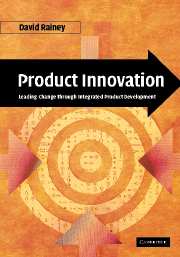Book contents
- Frontmatter
- Contents
- Preface
- Acknowledgements
- Part I Product innovation and strategic logic
- Part II Establishing the foundation: the conceptual level
- Part III Methods and techniques for analysis and decision making
- Part IV The operational level and concluding remarks
- Glossary
- References
- Select bibliography
- Index
Part III - Methods and techniques for analysis and decision making
Published online by Cambridge University Press: 10 August 2009
- Frontmatter
- Contents
- Preface
- Acknowledgements
- Part I Product innovation and strategic logic
- Part II Establishing the foundation: the conceptual level
- Part III Methods and techniques for analysis and decision making
- Part IV The operational level and concluding remarks
- Glossary
- References
- Select bibliography
- Index
Summary
Introduction
Managing new-product development (NPD) includes developing a model or framework, creating an effective NPD process, understanding the organizational implications, and determining and using the methods and techniques for analysis and decision making. Part III provides a schematic presentation and discussion of the essential mechanisms for analyzing the decisions and solutions required for maintaining the flow of the NPD process. The various methods and techniques are divided into the fundamental categories used for developing new products from an internal perspective. The areas include: product/market considerations, marketing strategies and programs, production strategies and programs, and financial applications and implications.
The methods and techniques discussed in Chapters 7 to 10 are typically the more-sophisticated approaches used during the later phases of the NPD process. However, some of the methods and techniques may be applied during the conceptual level as well. As discussed earlier, the applications depend on the type of new product and the complexities involved in the program. The more complex the NPD program, the more likely it is that sophisticated methods will be used during the earlier phases of the NPD process.
These chapters are intended to provide a broad understanding of the methods and techniques so that practitioners understand the fundamentals of their discipline as well as those of their colleagues. It is imperative that the specialists in each of the main disciplines have a working knowledge of the approaches used to make decisions.
- Type
- Chapter
- Information
- Product InnovationLeading Change through Integrated Product Development, pp. 281 - 282Publisher: Cambridge University PressPrint publication year: 2005



